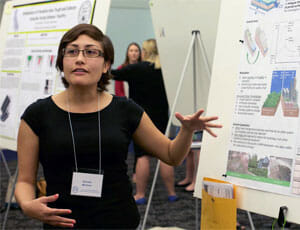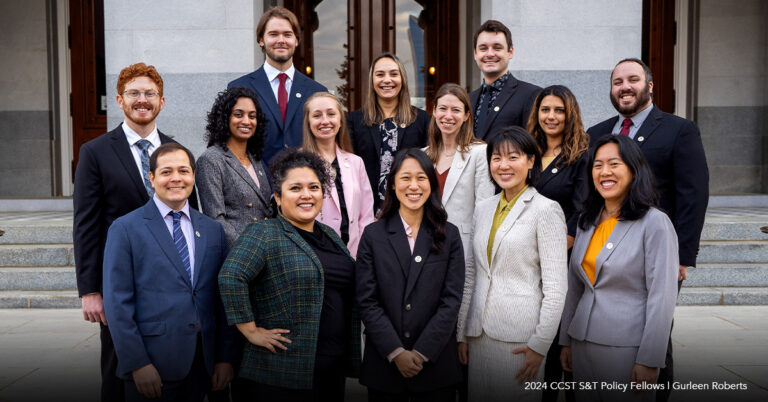Update: Applications for the CCST Science & Technology Policy Fellowship Have Closed
Cal State LA’s NASA Careers Program Taking Underrepresented Students to New Heights
May 19, 2016 | CCST Newsroom, Press Releases | Contact: M. Daniel Decillis

One year ago, NASA Jet Propulsion Laboratory (JPL) and California State University, Los Angeles (Cal State LA) gave 13 underrepresented undergraduate and graduate students an opportunity to literally shoot for the stars. Earlier this May, these students shared the initial fruits of this new career development program.
A $5 million grant from NASA’s Minority University Research and Education Project (MUREP) helped create the NASA Data Intensive Research and Education Center in STEM (NASA DIRECT-STEM) at Cal State LA. The program allowed Cal State LA to recruit highly competitive, historically underrepresented students, giving them the opportunity to work directly with researchers at JPL as well as University of California Irvine. This inaugural cohort of students have gained valuable experience in scientific computing and data analysis related to earth and space sciences – setting them off on PhD career paths in science, technology, engineering, and mathematics fields.
“The goal is to open up new avenues for finding future leaders in STEM-related professions, and cultivate new, diverse talent for NASA and other space and earth science institutions,” said Susan Hackwood, CCST Executive Director and an External Advisory Committee Board member of Cal State LA’s NASA DIRECT-STEM program. “I’m thrilled to see how this partnership is giving underrepresented students the chance to conduct collaborative research with world-class scientists and engineers at JPL and at UC Irvine.”
On May 6th, students from Cal State LA and UC Irvine participating in the NASA DIRECT-STEM program shared their research presentations. At this inaugural symposium, student research topics ranged from observations of protostellar disk accretion in faraway nebula, to rainfall estimation here on Earth, using data from a variety of NASA satellites and research programs.
“Even though this project is in its first year, it is gratifying to see that it has already started to have an impact on students participating in the project,” said program co-coordinator Soroosh Sorooshian, Distinguished Professor of Civil and Environmental Engineering and Director of the Center for Hydrometeorology and Remote Sensing at the UC Irvine, as well as a member of the CCST Council. “One Cal State LA masters student, Jinny Lee, became so interested and enthusiastic about the work of Professor Kuolin Hsu and his team here at UC Irvine – research related to satellite precipitation observation – that she decided to pursue a PhD degree in the program.”
In addition to the annual symposium, the Cal State LA program hosts a variety of other activities year round, including monthly interdisciplinary seminars and workshops for students of all levels.
“Ultimately our aim is to promote STEM literacy to communities in the greater Los Angeles Basin,” said Hengchun Ye, Director of the NASA DIRECT-STEM Program and a Professor of Geosciences & Environment at Cal State LA. “STEM disciplines are historically not very popular among underrepresented groups. Many minority students simply have not had the chance for positive exposure to these fields and come away with the impression that STEM is too difficult. We help provide training to compensate for this, as part of a structure of student recruiting, mentoring, and training.”
Cal State LA was not the only California institution to benefit from this suite of NASA MUREP grants. San Jose state was awarded up to $5 million to create the NASA MIRO Center for Applied Atmospheric Research and Education (CAARE); UC Riverside was awarded nearly $4.5 million to create the Fellowships and Internships in Extremely Large Data Sets (FIELDS)program; and UC Merced was awarded $5 million to create the Merced nAnomaterials Center for Energy and Sensing (MACES)program.
M. Daniel DeCillis, PhD is the Spotlight editor and a Senior Research Associate at the California Council on Science and Technology.
The California Council on Science and Technology (CCST) is a nonpartisan, not-for-profit organization established via the California State Assembly – making California’s policies stronger with science since 1988. CCST provides California’s Executive and Legislative Branches with independent scientific advice, convening a diverse network of expertise spanning California’s public and private universities, community colleges, and Federal research laboratories.
- California State University System
- University of California System
- California Community Colleges
- Caltech
- NASA Jet Propulsion Laboratory
Follow CCST on Facebook, on Twitter, and on LinkedIn.
CCST Sustaining Institutions and Affiliates Featured: California State University System; University of California System; California Community Colleges; Caltech; NASA Jet Propulsion Laboratory.






